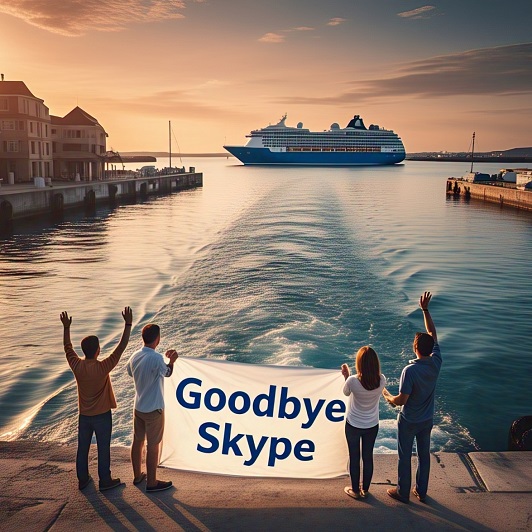
Skype has officially shut down as of 5 May 2025, marking the end of one of the most recognisable names in digital communication after a 23-year run.
A Platform That Defined an Era
Launched in 2003 by a small team of Estonian and Scandinavian developers, Skype quickly became the go-to app for free internet-based voice and video calls. For many, it was the first experience of seeing and hearing someone across the world at the click of a button. By 2010, the platform boasted over 660 million registered users, and its influence was so widespread that “to Skype” became a verb.
Skype was acquired by Microsoft in 2011 for $8.5 billion, and at the time, it was still seen as a powerful alternative to traditional phone services. It was integrated into Xbox, Outlook, and even some TV sets. It offered low-cost international calling, instant messaging, file sharing, and video conferencing, all in one platform.
That’s All Folks
However, from 5 May 2025, Skype is officially no more, and not just the free version. Microsoft has now ended both its free and paid consumer Skype services, with only Skype for Business (a separate enterprise-grade service) continuing (for now).
Why Now, And What Went Wrong?
Although Skype’s decline wasn’t sudden, it was quite sharp. This is really because despite being an early leader in internet calling, Skype failed to adapt to the modern demands of video communication. Also, the arrival of Zoom, Google Meet, FaceTime, and Discord seemed to expose Skype’s ageing infrastructure and increasingly clunky user experience.
The Pandemic Factor
What really sealed Skype’s fate was the shift in user expectations during the pandemic. For example, Zoom’s frictionless interface, combined with aggressive marketing and scalability, allowed it to soar in popularity, hosting 300 million daily meeting participants by 2020.
Invested In Teams Instead
Skype, by contrast, stumbled, and it was Microsoft’s decision to invest heavily in Teams rather than modernise Skype that also played a key role in Skype’s demise. Teams, which began life as a workplace collaboration tool, gained traction rapidly and now offers calling, chat, meetings, calendar, and app integrations. Its ability to scale for up to 10,000 participants made it the preferred platform for businesses and large organisations.
On 28 February 2025, Microsoft officially announced Skype would be retired by 5 May, stating: “We are streamlining our communications tools and prioritising Teams as our unified platform for calls, chat, and collaboration.”
What’s Actually Been Shut Down?
The closure affects all free and paid versions of Skype, except for Skype for Business, which continues for enterprise clients under a different support plan. Skype Credit, Skype Numbers, and new subscriptions were frozen in early April. Existing subscriptions will run until they expire, but no new purchases or renewals are allowed. SMS services, caller ID setup, and Skype Credit gifting have all been disabled.
Users who relied on Skype for calling are being directed to Microsoft Teams Free. This new version allows people to sign in using their Skype credentials, where their chat history and contacts will be automatically transferred. The Teams app includes the Skype Dial Pad, so paid users can continue to make and receive calls (for now).
Skype Data Accessible Until Jan 2026
Microsoft is keen to point out that data from Skype accounts will remain accessible until January 2026, at which point it will be deleted unless users have exported or migrated it to Teams.
What Should Skype Users Do Now?
Former Skype users, therefore, now have two choices, i.e. either migrate to Microsoft Teams Free or export their data and move to a different provider. It should be noted that the transition is relatively smooth and is just a case of users signing into Teams using their Skype login, where they will then find their existing contacts and chats waiting for them. However, not everything makes the move. It seems that private messages, bot conversations, and chats with Teams work or school accounts aren’t carried over.
For users who’d rather part ways with Microsoft altogether, it’s a case of needing to export their Skype data. This involves users logging in via the Skype web portal and requesting their contacts, chat history, and files. Once exported, users can download their data and switch to another provider.
What Are the Best Skype Alternatives Now?
The video calling market has grown considerably since Skype’s heyday, with several viable options now competing for attention. These include:
– Zoom. Still a favourite for businesses and individuals, offering high-quality calls, whiteboarding, and AI summaries. Free tier includes 40-minute meetings; paid plans start at £13/month.
– Google Meet. Integrated with Gmail and Google Calendar, it offers 100-participant meetings on the free plan, with AI tools and livestreaming available on paid tiers.
– Webex. Cisco’s platform includes breakout rooms, polls, and AI assistants, but the free version also has a 40-minute cap.
– Discord. Originally built for gamers, now used by small teams and communities. Unlimited meeting length and screen sharing included, though it caps participants at 25.
– Signal. Encrypted and simple to use for group video calls of up to 50 people. Entirely free.
– Slack Huddles. Great for quick team chats and casual check-ins. Free plan only supports 1:1 calls.
While each offers something Skype didn’t, none have yet fully filled the cultural or emotional space Skype once held.
What’s Changing for Microsoft and the Market?
From Microsoft’s perspective, shutting down Skype is less about losing a legacy product and more about simplifying its platform offering. Teams, now used by more than 320 million people globally, consolidates many of Skype’s core functions and integrates them into a single environment alongside productivity tools.
That said, the move isn’t without its critics. Skype earned its reputation by being lightweight and universally accessible. These are both attributes not always associated with Teams. Also, for individuals and smaller businesses used to Skype’s intuitive interface, the transition may feel like a leap into a more complex, corporate world.
The change also reflects a broader industry trend. Tech giants are increasingly streamlining their digital offerings, partly to improve user experience and partly to cut back on the environmental impact of maintaining sprawling product ecosystems. In Microsoft’s case, retiring Skype may help reduce server loads, lower duplication across services, and focus engineering resources on fewer, more efficient platforms.
For competitors like Zoom and Google, the exit of Skype finally removes a once-major rival from the table, but the growing dominance of Teams, particularly in the workplace, means the battle for users is far from over. With AI, sustainability, and integration now key differentiators, the next few years could see even more dramatic shifts in how we connect online.
What Does This Mean For Your Business?
Skype’s disappearance may come as a surprise to some, but in truth, the writing has been on the wall for years. Its early success was rooted in simplicity, accessibility, and a genuine sense of global connection. However, those very strengths became liabilities in a market that rapidly shifted toward multi-functional, integrated platforms. As for the switch to Teams, it isn’t just a change of software – it’s a shift in mindset, especially for those who valued Skype as a lightweight, personal tool rather than a business suite in disguise.
For UK businesses, on the one hand, smaller firms and sole traders who relied on Skype for informal calls or affordable international communication may now feel pushed into adopting a heavier, more corporate solution. On the other hand, the move to Teams could streamline digital communications and bring them in line with broader productivity tools already in use, such as Office 365 and SharePoint. For larger organisations, especially those managing hybrid or distributed teams, the integration offered by Teams could well prove to be a long-term advantage.
From a market perspective, Skype’s departure may reduce fragmentation but doesn’t lessen competition. The race to provide smarter, leaner, more secure communication tools is still very much on, and with AI-enhanced features now becoming the norm, the tools of tomorrow may look very different again. For Microsoft, consolidating platforms under the Teams umbrella is a clear statement of intent. For rivals, it’s a reminder that dominance is never guaranteed.
Skype’s end, therefore, highlights how fast the digital landscape evolves, and how even the most familiar names can fade if they don’t adapt. On the upside, Skype’s departure clears the way for new tools, new habits, and possibly, better solutions, not just for businesses, but for everyone who relies on connection as a core part of how they work and live.




